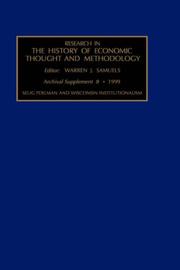| Listing 1 - 10 of 30 | << page >> |
Sort by
|
Article
Year: 2000
Abstract | Keywords | Export | Availability | Bookmark
 Loading...
Loading...Choose an application
- Reference Manager
- EndNote
- RefWorks (Direct export to RefWorks)
Book
Year: 1963 Publisher: Paris PUF
Abstract | Keywords | Export | Availability | Bookmark
 Loading...
Loading...Choose an application
- Reference Manager
- EndNote
- RefWorks (Direct export to RefWorks)
capitalisme --- Histoire de la pensée économique --- Anthropologie économique

ISBN: 0762305959 Year: 1999 Publisher: Stamford (Conn.) : Jai Press,
Abstract | Keywords | Export | Availability | Bookmark
 Loading...
Loading...Choose an application
- Reference Manager
- EndNote
- RefWorks (Direct export to RefWorks)
Economie politique --- Histoire de la pensee economique --- Histoire

ISBN: 1862075964 9781862075962 Year: 2002 Publisher: London Granta Books
Abstract | Keywords | Export | Availability | Bookmark
 Loading...
Loading...Choose an application
- Reference Manager
- EndNote
- RefWorks (Direct export to RefWorks)
A radical work of philosophy, which sets out to challenge our most cherished assumptions about what it means to be human. From Plato to Christianity, from the Enlightenment to Nietzsche and Marx, the Western tradition has been based on arrogant and erroneous beliefs about human beings and their place in the world. Philosophies such as liberalism and Marxism think of humankind as a species whose destiny is to transcend natural limits and conquer the Earth. Even in the present day, despite Darwin's discoveries, nearly all schools of thought take as their starting point the belief that humans are radically different from other animals. John Gray argues that this humanist belief in human difference is an illusion and explores how the world and human life look once humanism has been finally abandoned.
Humanism. --- existentialisme --- Histoire de la pensée économique --- Individu et société --- Humanism
Dissertation
Year: 2016 Publisher: Liège Université de Liège (ULiège)
Abstract | Keywords | Export | Availability | Bookmark
 Loading...
Loading...Choose an application
- Reference Manager
- EndNote
- RefWorks (Direct export to RefWorks)
Le présent mémoire traite des écarts salariaux entre femmes et hommes et entend évacuer la confusion entre différences de revenus et inégalités de traitement pour un travail équivalent. Nous souhaitons essentiellement poursuivre trois buts. Définir le gender pay gap en présentant la littérature traitant des différences de genre dans l’accès au marché du travail ; confronter ces caractéristiques à l’analyse des données récentes de la Labor Force Survey pour la Belgique ; et tirer des conclusions éventuellement transposables en orientations pour la prise de décision publique. L’idée générale est de confronter les initiatives politiques et législatives luttant contre les discriminations de sexe aux inégalités profondes observables dans la construction du marché du travail.
Dissertation
Year: 2016 Publisher: Liège Université de Liège (ULiège)
Abstract | Keywords | Export | Availability | Bookmark
 Loading...
Loading...Choose an application
- Reference Manager
- EndNote
- RefWorks (Direct export to RefWorks)
The definition of a relevant market is crucial in many antitrust cases. The assessment whether a firm is in a dominant position or not depends highly on the market that has been defined as comprising all competitive constraints to its behaviour. The ongoing case of the European Commission against Google’s mobile operating system Android is an example of such a case, which additionally includes a very specific type of product: multi-sided platforms. The particular nature and functioning of such platforms leaves most common methods of market definition useless and inappropriate. This thesis will use the growing literature on multi-sided platforms to assess the functioning of these products. Further, a prominent precedent case and a close consideration of the general business strategy of Google will help to reveal and to understand how Android works. What role it and other adjacent software play in this wider business strategy of Google. And what the competitive environment is in which these products are operated. The main insights will be that it makes little sense to consider these products without taking into account their interdependent relationship and the competition they face from firms operating with a different business model. It are in fact these various business models that are competing with each other on a higher level, rather than the single products with each other. Comparing these findings with the markets the European Commission has defined as being the relevant markets in this case, hints that the Commission might possibly be missing important aspects of the competition that is taking place between these products and their parent firms.
Dissertation
Year: 2017 Publisher: Liège Université de Liège (ULiège)
Abstract | Keywords | Export | Availability | Bookmark
 Loading...
Loading...Choose an application
- Reference Manager
- EndNote
- RefWorks (Direct export to RefWorks)
Basic income, utopia or dystopia? In recent years, this issue has frequently been discussed in the public debate. Indeed, one must say that the proposal is enticing: to give to each and everyone an identical income - more or less important -, regardless of one's living standard, patrimony or personal situation. For those in favor, this income would eradicate poverty, provide support to the most precarious, and promote self-entrepreneurship. This study raises the question of whether such an income would be beneficial to the society in general. It analyzes in a critical way the history of the idea, its models, and their impact on the economic policy. Eventually, this document addresses the issue of work automatization. As a conclusion, this Master Thesis overviews different alternatives to the basic income, in the hope that such thoughts will help to contribute to a more sustainable future.
Dissertation
Year: 2020 Publisher: Liège Université de Liège (ULiège)
Abstract | Keywords | Export | Availability | Bookmark
 Loading...
Loading...Choose an application
- Reference Manager
- EndNote
- RefWorks (Direct export to RefWorks)
Tourism is developing at an exceptional speed between the different countries. In order to stand out from one another, tourism organizations are highlighting event tourism that not only attract tourists but also put the destination in the spotlight. The events are intended to attract tourists in order to generate economic growth. Tourists will have certain needs that the local economy will supplement by employing labour and generating income. The economic impacts associated with events are numerous but, contrary to popular belief, they are not always positive. In order to identify these impacts, researchers use different methods: this paper highlights the IO model and the CGE analysis. \ In order to analyse the theory, the case of the Liège Christmas market will be analysed. Christmas markets are special cases in cultural events because visitors do not have the same expectations at Christmas markets as at other cultural events. In fact, we can see that most Christmas markets do not meet visitors' expectations and that the economic benefits could be much greater if organizers paid more attention to them.
Dissertation
Year: 2021 Publisher: Liège Université de Liège (ULiège)
Abstract | Keywords | Export | Availability | Bookmark
 Loading...
Loading...Choose an application
- Reference Manager
- EndNote
- RefWorks (Direct export to RefWorks)
This work deals with different sectors’ performances towards achieving the Sustainable growth pillar’s objectives from the Europe 2020 strategy. First, we determine the objectives at the sectoral level according to the country-level set objectives. Then we define a composite index for the whole Sustainable growth pillar and finally propose a decomposition of that composite index. This decomposition provides important insight, by differentiating between three different components of the Sustainable growth pillar: sector-, group-, and objective-specific indexes. The decomposition, therefore, allows for a better understanding of the realisation of the set objectives at the sectoral level, since the composite index alone leads to confusion about all plausible reasons explaining the given outcome. Applying the methodology to 8 sectors within the 27 European Union countries for the period 2004-2018, we found that while performances have increased over time, compelling efforts are still required to achieve the Europe 2020 Sustainable growth pillar objectives, especially the Energy efficiency and the Renewable energy share targets, as portrayed by the objective-specific index results. The decomposition allows us to emphasise the important patterns and challenges for each sector at the three levels.
Dissertation
Year: 2023 Publisher: Liège Université de Liège (ULiège)
Abstract | Keywords | Export | Availability | Bookmark
 Loading...
Loading...Choose an application
- Reference Manager
- EndNote
- RefWorks (Direct export to RefWorks)
In 2010 the European Union adopted the Europe 2020 Strategy, a ten-year plan which aimed to deliver smart, sustainable and inclusive growth. These three pillars were organised into five targets focused on employment, the reduction of poverty and social exclusion, education, research and development (R&D), climate change and energy sustainability. These targets were not only defined for the European Union as a whole. Each Member States had its own national targets agreed on based on the current economic and social situations and on its potential achievements. Furter, data about the results of the different regions within the countries are available which allows to investigate how conditions and performances can vary even within the same nation. This thesis presents an analysis of the achievements relative to the Europe 2020 Strategy reached by Member States by comparing the performances of Member States with high and with low Global Competitiveness Index (GCI) as of 2010, the year of the inception of the Strategy. In order to do this, we apply a decomposition of the composite indexes as proposed by Walheer (2018). Applying composite indexes alone can generate confusion about real reasons of the results obtained. Thanks to the decomposed indexes, which are country-, group-, and objective-specific indexes, we can instead identify the causes of better and worse performances of the countries towards their Europe 2020 targets. The decision to base the countries’ classification on the GCI is due to the fact that this index is an assessment of countries’ competitiveness. Building a more competitive Europe is indeed the overall aim of the Europe 2020. Furthermore, we choose to focus on one Member State, Italy, to measure its progresses toward the targets of the Europe 2020 at the regional level. The analysis is carried out with the decomposition of the composite indexes applied to EU countries as seen in Walheer (2018). It is interesting to investigate the differences in the results of North-Centre regions and the so-called Mezzogiorno, which includes the regions of Abruzzo, Apulia, Basilicata, Calabria, Campania, Molise, Sardinia and Sicily, because of the competitiveness disparity between these two areas that has characterised Italy since of its creation as a nation and that no policies or reforms have been able to lessen significantly. Therefore, our research questions are the following: 1.What are the performances of high and low GCI EU Members States towards achieving the Europe 2020 Strategy objectives?2.Is the competitiveness gap between North-Centre and Mezzogiorno regions of Italy reflected in different Europe 2020 Strategy performances?
| Listing 1 - 10 of 30 | << page >> |
Sort by
|

 Search
Search Feedback
Feedback About UniCat
About UniCat  Help
Help News
News